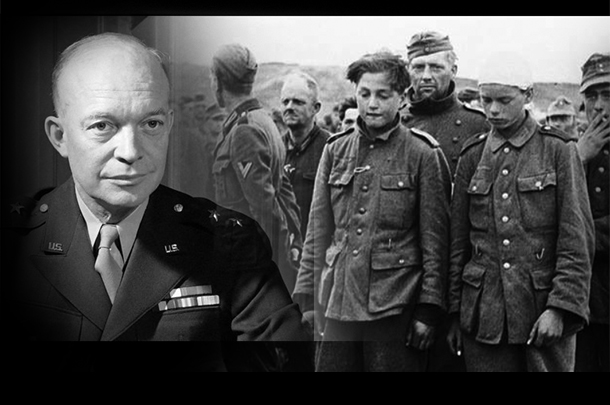An uncomfortable secret, revealed between the lines of history.

Nial McCrae
21st Century Wire
A vast field is filled as far as the eye can see with miserable and gaunt men in remnants of military uniform. It’s May 1945 and the war in Europe has ended. By rights, these surrendered soldiers will be allowed to return to their families, but many will not leave this muddy ground alive. There is no food, no shelter, and no medicine. The Rheinwiesenlager (Rhine meadow camps) were the killing fields of one of the worst war crimes in modern history, committed by General Dwight Eisenhower and the US Army.
The cull of German troops was a closely-guarded secret until four decades after the war, when a Canadian researcher was writing a book on a French resistance hero. James Bacque found that his subject, Raou Laporterie, had been saved by a German soldier, Hans Goertz. In gratitude, in 1946, Laporterie got Goertz out of a French prison camp to work in his chain of drapery stores. Goertz told of mass deaths of inmates through lack of sustenance.
After pursuing leads in the French records, Bacque came to realise that Allied military leaders had ‘committed an appalling crime against humanity’. His investigation culminated in Bacque’s harrowing book Other Losses: The Shocking Truth Behind the Mass Deaths Of Disarmed German Soldiers And Civilians Under General Eisenhower’s Command (1989). The foreword to this expose was written by Ernest Fisher, a retired colonel of the US Army, and war historian noted for his book Cassino to the Alps. Fisher set the scene: –
‘Over most of the western front in April 1945, the thunder of artillery had been replaced by the shuffling of millions of pairs of boots as columns of disarmed German soldiers marched wearily towards Allied barbed wire enclosures. Scattered enemy detachments fired a few volleys before fading into the countryside and eventual capture by Allied soldiers.’
As Fisher explained, German soldiers did everything they could to evade capture by the Russians, who raped and pillaged as they advanced over eastern Germany:
‘The mass surrenders in the west contrasted markedly with the final weeks on the eastern front where surviving Wehrmacht units still fought the advancing Red Army to enable as many of their comrades as possible to evade capture by the Russians. This was the final strategy of the German High Command then under Grand Admiral Doenitz who had been designated Commander-in-Chief by Adolf Hitler.’
But crossing to the Allied side was not the sanctuary that the defeated Germans expected, due to the visceral hatred of Eisenhower. The supreme military commander, of Swedish-Jewish background, had wriiten in a letter to his wife ‘God, I hate the Germans’. In September 1944, in the presence of the British ambassador to Washington, Eisenhower proposed that the entire German general staff, all officers of the Gestapo and all leaders of the Nazi party from mayor upwards should be exterminated (around a hundred thousand men).
Fisher had met Bacque in Washington in 1987 where they uncovered evidence, deeply buried in national archives, of a systematic slaughter. ‘More than five million German soldiers in the American and French zones were crowded into barbed wire cages, many of them literally shoulder to shoulder. The ground beneath them became a quagmire of filth and disease. Open to the weather, lacking even primitive sanitary facilities, underfed, the prisoners soon began dying of starvation.’
Shockingly, more German soldiers died in the camps from April 1945 onwards than died in combat.
In the archives, Bacque studied each edition of the ‘Weekly Prisoner of War and Disarmed Enemy Forces Report’, which showed a high number in the category of ‘other losses’. As escape was almost impossible, these men must have died in the camps. According to Bacque:
‘The victims undoubtedly number over 800,000 and quite likely over a million. Their deaths were knowingly caused by army officers who had sufficient resources to keep the prisoners alive. Relief organizations that attempted to help the prisoners in the American camps were refused permission by the army. All of this was hidden at the time; then lied about when the Red Cross, Le Mondé and Le Figaro attempted to tell the truth publicly.’
Ominously, on 26th April 1945 the combined chiefs-of-staff at Reims decided to create the status of ‘disarmed enemy forces’. This category would apply to ‘prisoners-of-war in American hands only’. No public declaration was made of this bypassing of the Geneva Convention. Mortality data were censored by the American military authorities, who exploited their control of media to push propaganda about their humane treatment of prisoners.
With German soldiers failing to come home in the months after the war ended, the myth of a ‘world food shortage’ was used, a contrived crisis blamed on the Germans. Yet despite the war, there was ample supply of wheat and corn The Swiss Red Cross had thirteen and-a-half million food parcels intended for prisoners, which would have prevented any death from starvation, but this provision was blocked. Indeed, the Red Cross was prevented from entering the camps, as Bacque explained:
‘Granting permission for the welfare agencies to visit the camps would have led to a storm of public protest against the atrocious conditions, while at the same time producing the workers and political will needed to alleviate them. It can hardly be doubted that this was why permission was not given.’
Eisenhower’s accomplice in this cruelty was an old friend of his from military training. Appointed as Eisenhower’s right-hand man, General Everett S Hughes took an extraordinary interest in prisoners’ rations, which he deviously reduced by as much as he could.
The British were innocent in this massacre, its German prisoners dying at no more than an expected rate, because they were fed and housed appropriately. Bacque’s book begins with a conversation at the banqueting table at the Yalta conference in 1943. Joseph Stalin expressed his desire to shoot a line of fifty thousand German officers. Franklin Roosevelt suggested a compromise of 49 thousand, before his son Elliott, a brigadier-general in the US Army, added to the proposed cull hundreds of thousands of Nazis. Winston Churchill stormed out, after stating ‘I would rather be taken out in the garden here and now to be shot myself than sully my own and my country’s honour by such infamy’.
There is another part to this dark episode. General George Patton, a magnanimous victor who respected the Germans as a people, was disgusted by Eisenhower, accusing him of Gestapo practices. Patton, whose Third Army had rapidly swept through northern France after the D-Day landings, due to his brilliant tactics, made himself unpopular with the US military establishment after the war was won. A thorn in the side of Eisenhower, he suggested that the Germans be rearmed to fight the communist Russians.
As described in a Daily Mail article (21 December 2019), General Patton MURDERED? Mystery pertaining to the suspicious death of the general 74 years later, Patton’s death at the end of1945 was later suspected as an assassination. In 1979 Second World War spy Douglas Bazata claimed that he was ordered by the Office of Strategic Services (forerunner of the CIA).to kill Patton and make it look like an accident. Patton was driving a Cadillac in Mannheim when he collided with a military truck. He was paralysed from the head down, but recovered sufficiently in an army hospital for medical clearance to fly back to the USA. On 21st December, the day before his flight, he died suddenly. There was no autopsy, and medical records disappeared.
Was Patton killed because he knew too much about the death camps, and was as much of a maverick to risk the dirty secret coming out?
***
Niall McCrae is a researcher and educator, and author of ‘The Moon and Madness’ (Imprint Academic, 2011), and ‘Moralitis: a Cultural Virus’ (Bruges Group, 2018). See his 21WIRE archive here.
READ MORE HISTORY NEWS AT: 21st CENTURY WIRE HISTORY FILES
ALSO JOIN OUR TELEGRAM CHANNEL
SUPPORT OUR INDEPENDENT MEDIA PLATFORM – BECOME A MEMBER @21WIRE.TV
















